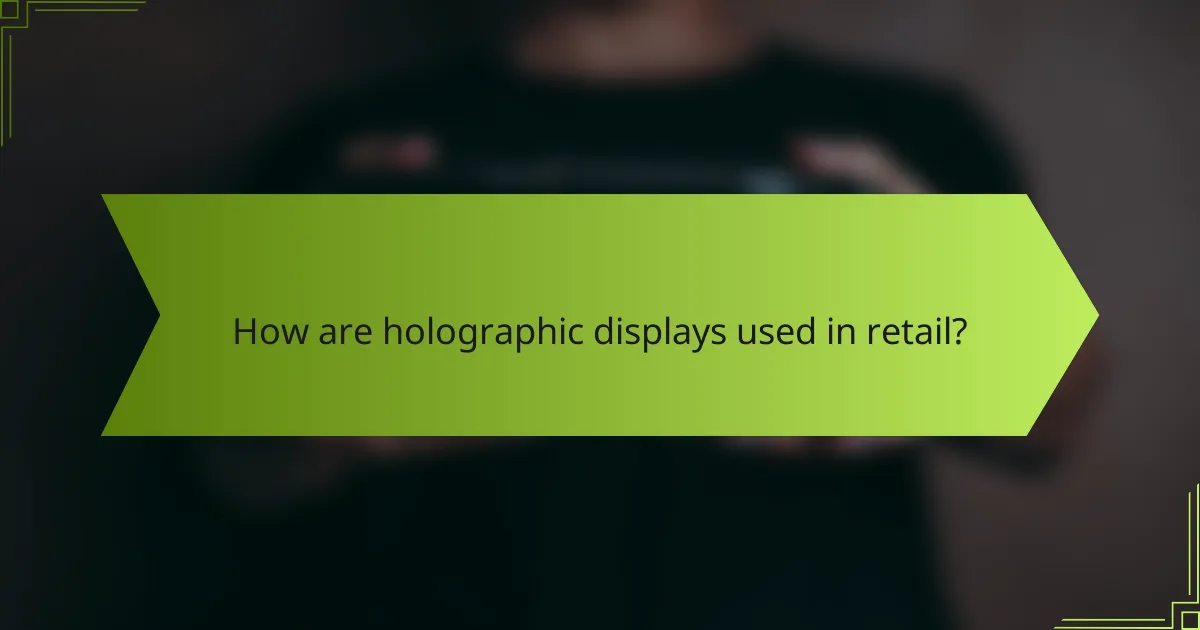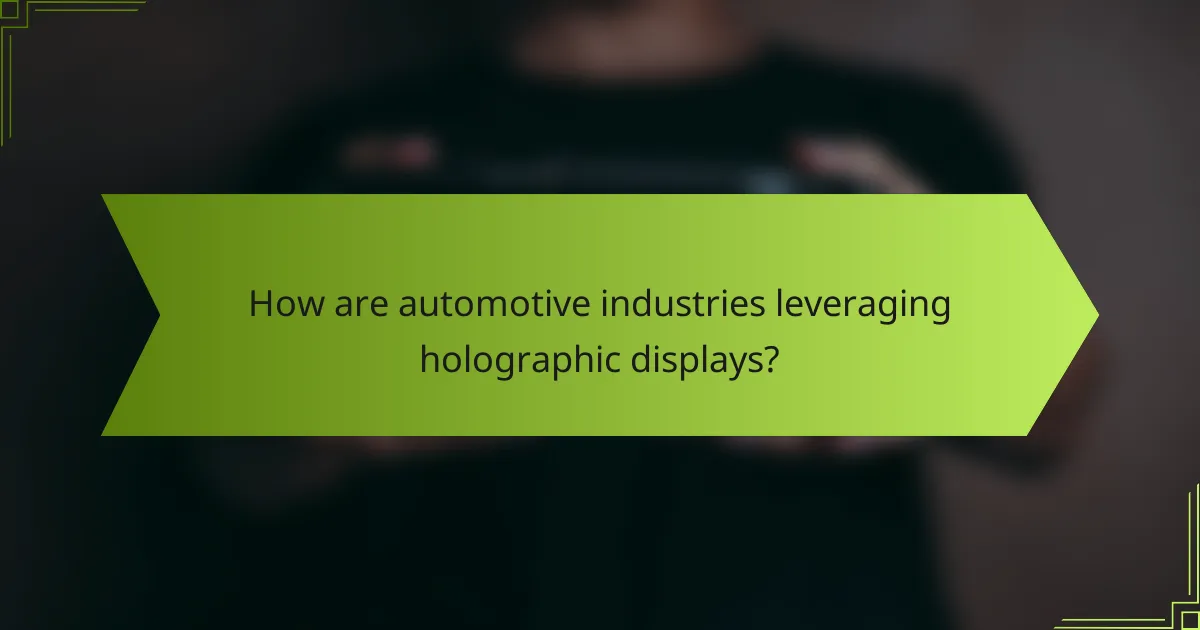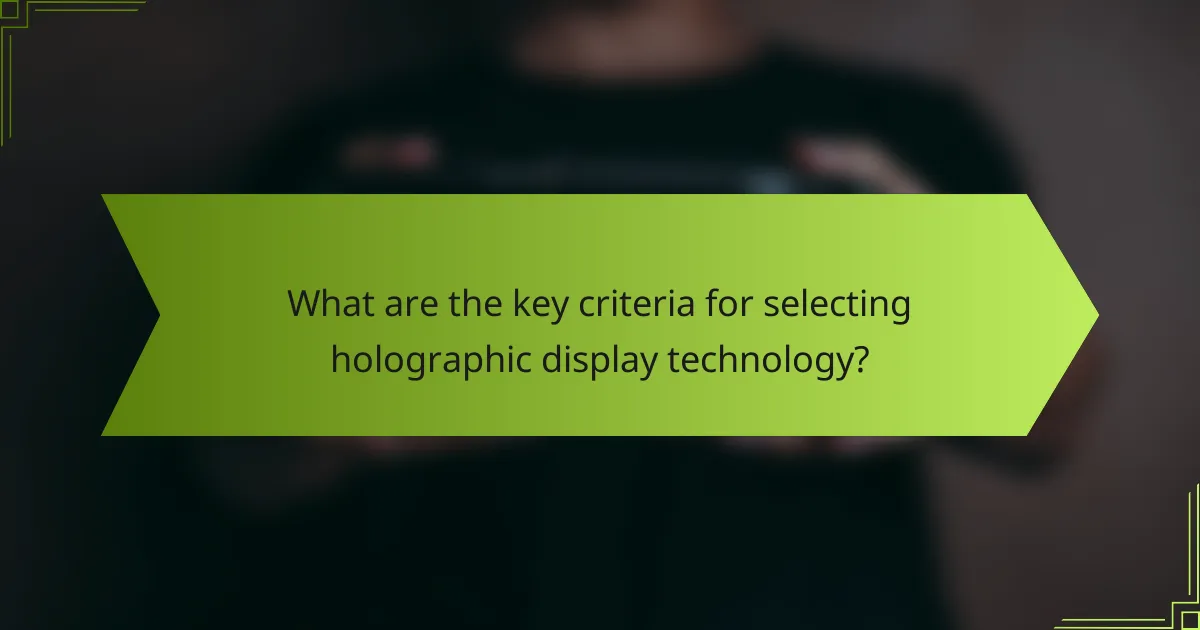Holographic displays are transforming various industries by offering innovative ways to engage users and enhance experiences. In retail, they create immersive shopping environments, while in education, they facilitate deeper understanding through interactive visualizations. The healthcare sector benefits from improved patient engagement and advanced visualization techniques, and marketing leverages these displays to create captivating promotional content. Additionally, the automotive industry utilizes holography for design and training purposes, showcasing the versatility and impact of this technology across multiple fields.

How are holographic displays used in retail?
Holographic displays in retail enhance customer experiences by providing immersive and interactive visualizations of products. These displays allow retailers to showcase items in a dynamic way, making shopping more engaging and informative.
Interactive product displays
Interactive product displays utilize holographic technology to present items in 3D, allowing customers to view products from multiple angles. This can significantly enhance product understanding, as shoppers can see intricate details that traditional displays may not convey.
Retailers can create engaging experiences by incorporating touch-sensitive features, enabling customers to interact with the display. For instance, a holographic display could allow a user to rotate a product or view different color options simply by touching the screen.
Virtual try-on solutions
Virtual try-on solutions leverage holographic displays to allow customers to visualize how products, such as clothing or accessories, would look on them without physically trying them on. This technology uses augmented reality to superimpose products onto the customer’s image in real-time.
These solutions can reduce the need for physical fitting rooms, streamlining the shopping process. Retailers can enhance this experience by offering personalized recommendations based on the customer’s preferences and body measurements.
Customer engagement experiences
Holographic displays can create unique customer engagement experiences that draw shoppers into the store. For example, retailers can use holograms to tell a brand story or showcase product features in an engaging narrative format.
Additionally, incorporating gamification elements, such as interactive quizzes or competitions displayed through holograms, can increase foot traffic and dwell time. Retailers should ensure that these experiences are easy to navigate and provide clear value to the customer to maximize effectiveness.

What benefits do holographic displays offer in education?
Holographic displays provide significant advantages in education by enhancing engagement and improving comprehension. These displays create three-dimensional visualizations that allow students to interact with content in a more meaningful way.
Enhanced visual learning
Holographic displays facilitate enhanced visual learning by presenting complex information in a more digestible format. For instance, students can visualize anatomical structures in 3D, making it easier to understand spatial relationships and functions. This method caters to various learning styles, especially for visual learners who benefit from seeing concepts in action.
Additionally, these displays can help simplify abstract concepts in subjects like mathematics and physics, allowing students to manipulate and explore them interactively. This hands-on approach can lead to better retention and understanding of the material.
Immersive training simulations
Holographic displays enable immersive training simulations that replicate real-world scenarios, particularly in fields like medicine and engineering. For example, medical students can practice surgical procedures in a risk-free environment, honing their skills before working with actual patients. This type of training can significantly reduce the learning curve and improve confidence.
Moreover, these simulations can be tailored to individual learning paces, allowing students to repeat exercises until they achieve proficiency. This flexibility is crucial in high-stakes fields where precision is paramount.
Collaboration tools for remote learning
Holographic displays serve as powerful collaboration tools for remote learning, fostering interactive group work regardless of participants’ locations. Students can share holographic models and engage in discussions as if they were in the same room, enhancing teamwork and communication skills.
These tools can also bridge gaps in accessibility, allowing students from different regions to access high-quality educational resources. By integrating holographic technology into online platforms, educators can create a more inclusive and engaging learning environment.

How are holographic displays transforming healthcare?
Holographic displays are revolutionizing healthcare by enhancing visualization, improving patient engagement, and facilitating remote consultations. These technologies enable medical professionals to interact with three-dimensional representations of anatomy and medical data, leading to better outcomes and more informed patients.
3D visualization for surgeries
Holographic displays provide surgeons with a three-dimensional view of complex anatomical structures, which can significantly enhance precision during operations. By visualizing critical organs and tissues from various angles, surgeons can plan and execute procedures with improved accuracy. This technology is particularly beneficial in intricate surgeries, such as neurosurgery or orthopedic procedures, where spatial awareness is crucial.
For instance, a surgeon can overlay a holographic image of a patient’s anatomy onto their body during surgery, allowing for real-time guidance. This capability can reduce the risk of complications and improve recovery times.
Patient education tools
Holographic displays serve as effective tools for patient education by making complex medical information more accessible and engaging. Patients can interact with 3D models of their conditions, which helps them understand treatment options and procedures better. This interactive experience can lead to increased patient satisfaction and adherence to treatment plans.
For example, a patient diagnosed with a heart condition can view a holographic representation of their heart, allowing them to visualize the impact of various interventions. This clarity can empower patients to make informed decisions about their healthcare.
Telemedicine applications
In telemedicine, holographic displays enhance remote consultations by providing a more immersive experience for both healthcare providers and patients. Physicians can use holograms to simulate physical examinations or demonstrate treatment plans, bridging the gap created by distance. This technology can be especially valuable in rural areas where access to specialists is limited.
Moreover, holographic displays can facilitate collaborative consultations among multiple specialists, allowing them to visualize and discuss cases in real-time, regardless of their physical locations. This can lead to more comprehensive care and improved patient outcomes.

What role do holographic displays play in marketing?
Holographic displays are transforming marketing by creating engaging visual experiences that capture consumer attention. These displays allow brands to showcase products in a three-dimensional format, enhancing visibility and interaction.
Attention-grabbing advertisements
Holographic displays can significantly enhance advertisements by providing a unique visual appeal that stands out in crowded markets. Brands can use holograms to present products in a dynamic way, making them more memorable to potential customers.
For instance, a retail store might use a holographic display to project a new product in 3D, allowing customers to see it from various angles without physical interaction. This innovative approach can lead to increased foot traffic and higher conversion rates.
Brand storytelling through immersive experiences
Holographic displays enable brands to tell their stories in a more immersive manner, creating emotional connections with consumers. By integrating holograms into marketing campaigns, companies can illustrate their brand values and narratives in a visually compelling way.
For example, a travel agency could use holographic displays to recreate destinations, allowing potential travelers to experience the location’s allure before booking. This technique not only informs but also inspires action through vivid storytelling.
Event marketing enhancements
At events, holographic displays can elevate the overall experience by providing interactive and engaging presentations. Brands can use these displays to showcase products or services in a way that captivates attendees and encourages participation.
For instance, during a product launch, a holographic display can demonstrate features and benefits in real-time, allowing attendees to interact with the content. This approach can lead to higher engagement levels and a more memorable event experience, ultimately driving brand loyalty.

How are automotive industries leveraging holographic displays?
Automotive industries are increasingly utilizing holographic displays to enhance user experience and improve safety features. These advanced visual technologies provide immersive interactions, allowing drivers and passengers to access vital information without distraction.
Augmented reality dashboards
Augmented reality (AR) dashboards overlay digital information onto the physical environment, helping drivers stay informed while keeping their focus on the road. These displays can show speed, navigation, and other critical data directly on the windshield, reducing the need for drivers to glance away at traditional screens.
When implementing AR dashboards, manufacturers should consider factors like visibility in various lighting conditions and the potential for information overload. A well-designed AR interface should prioritize essential information and minimize distractions.
Virtual vehicle showcases
Virtual vehicle showcases allow potential buyers to explore car models in a fully interactive 3D environment. This technology enables users to view different features, colors, and configurations without the need for physical prototypes, making it easier for dealerships to present their inventory.
To maximize the effectiveness of virtual showcases, automotive companies should ensure high-quality graphics and user-friendly navigation. Engaging experiences can significantly enhance customer interest and lead to higher conversion rates.
Driver assistance systems
Holographic displays are integral to advanced driver assistance systems (ADAS), providing real-time feedback and alerts to enhance safety. These systems can project warnings about obstacles, lane departures, or speed limits directly in the driver’s line of sight, facilitating quicker reactions.
When integrating holographic technology into ADAS, manufacturers must ensure that the information is clear and easily interpretable. Testing in various driving conditions is crucial to ensure reliability and effectiveness, as well as compliance with safety regulations.

What are the key criteria for selecting holographic display technology?
When selecting holographic display technology, consider factors such as resolution, clarity, interactivity, and cost. These criteria will help determine the suitability of the technology for specific applications in industries like retail, education, healthcare, marketing, and automotive.
Resolution and clarity
Resolution and clarity are critical factors in holographic displays, as they directly impact the viewer’s experience. Higher resolution provides more detail, making images appear sharper and more lifelike. Look for displays with at least 1080p resolution for basic applications, while 4K or higher is preferable for more demanding uses.
Clarity also involves the display’s ability to render colors accurately and maintain brightness in various lighting conditions. Consider displays that utilize advanced technologies like OLED or microLED for better color reproduction and contrast. Testing displays in real-world environments can help assess their performance under different conditions.
